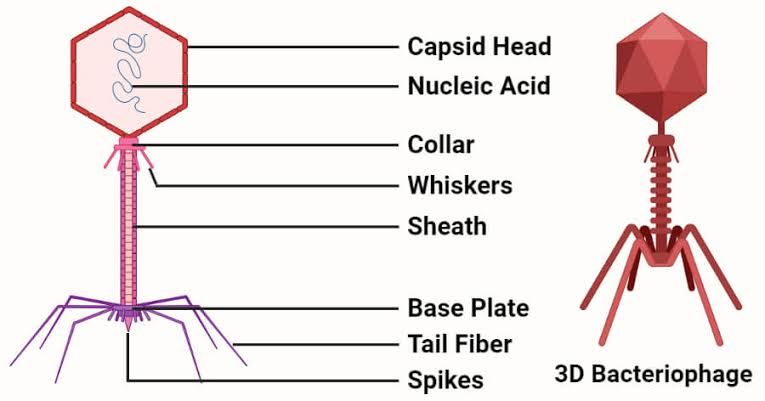
General Characteristics of Bacteriophages
Bacteriophages, or phages, are viruses that specifically infect bacteria. They are composed of nucleic acid (either DNA or RNA) encased in a protein coat called a capsid. Phages can be classified based on their structure, genome type, and replication cycle. Key characteristics include:
- Host Specificity: Phages are highly specific to their bacterial hosts, often infecting only certain strains or species.
- Morphology: They exhibit diverse shapes, including icosahedral, helical, and complex structures.
- Life Cycles: Phages can undergo lytic or lysogenic cycles depending on the environmental conditions and the type of phage.
Phage T4 – Structure
Phage T4 is a well-studied bacteriophage that infects Escherichia coli. Its structure includes:
- Head: The icosahedral head contains double-stranded DNA (dsDNA) and is surrounded by a protein shell.
- Tail: T4 has a long tail with a base plate and tail fibers that facilitate attachment to the bacterial cell surface.
- Sheath: The sheath contracts during infection to inject the viral DNA into the host cell.
Overall, T4’s structure is optimized for its role in infecting bacterial cells efficiently.
Gene Expression and Genome Organization
The genome of phage T4 is approximately 169 kb in length and encodes around 300 genes. Its organization can be divided into three functional regions:
- Early Genes: These genes are expressed immediately after infection and are involved in modifying the host’s machinery for viral replication.
- Middle Genes: Expressed shortly after early genes, these genes help in replicating the viral genome and synthesizing proteins necessary for phage assembly.
- Late Genes: These genes are expressed later in the infection cycle and encode structural proteins required for assembling new virions.
Gene expression is tightly regulated through various mechanisms to ensure efficient use of resources within the host cell.
λphage – Replication
λphage (lambda phage) is another well-studied bacteriophage that also infects E. coli but has distinct replication strategies:
- Lytic Cycle: In this cycle, λphage hijacks the host’s cellular machinery to produce new virions rapidly, leading to cell lysis and release of progeny phages.
- Lysogenic Cycle: Alternatively, λphage can integrate its genome into the host’s chromosome as a prophage. This allows it to replicate along with the host cell without causing immediate harm.
The choice between these two cycles depends on environmental factors such as nutrient availability and stress conditions.
Lytic and Lysogenic Cycles
The lytic cycle involves several stages:
- Attachment: The phage attaches to specific receptors on the bacterial surface.
- Penetration: The viral DNA is injected into the host cell.
- Biosynthesis: Host machinery synthesizes viral components using early, middle, and late gene expressions.
- Assembly: New virions are assembled from synthesized components.
- Release: The host cell lyses, releasing new phages.
In contrast, during the lysogenic cycle:
- The phage integrates its DNA into the bacterial chromosome as a prophage.
- It remains dormant until triggered by environmental factors (e.g., UV light), at which point it can enter the lytic cycle.
Transcription of Phage Genes
Transcription of phage genes occurs in a highly regulated manner during both lytic and lysogenic cycles:
- Early transcription begins immediately upon infection using host RNA polymerase to synthesize early mRNAs from early promoters.
- Middle transcription follows as early proteins modify RNA polymerase activity to recognize middle promoters.
- Late transcription occurs when structural proteins are synthesized from late promoters after sufficient viral components have been produced.
This sequential regulation ensures that gene expression aligns with different phases of infection.
Mechanisms of Repressor Synthesis and Its Control
In λphage’s lysogenic cycle, repressor proteins (such as CI protein) play crucial roles in maintaining lysogeny by preventing transcription of lytic genes:
- CI binds to operator sites on λ DNA, blocking RNA polymerase access to promoters for lytic gene expression.
- Environmental signals (like stress) can lead to repressor degradation or inhibition, allowing transition from lysogeny back to lysis.
This regulatory mechanism ensures survival under adverse conditions while enabling rapid response when conditions improve.
Autoregulation
Autoregulation refers to feedback mechanisms where gene products regulate their own expression levels:
- In λphage, CI protein not only represses lytic genes but also promotes its own synthesis by binding to its promoter region when present at adequate levels.
- This self-regulatory loop maintains appropriate levels of repressor protein necessary for sustaining lysogeny while allowing flexibility for transitioning back to lysis if needed.
Use of Phages as Cloning Vectors
Bacteriophages have been utilized as cloning vectors due to their ability to efficiently deliver genetic material into bacterial cells:
- Phagemids combine features of plasmids and bacteriophages; they allow for easy manipulation in laboratory settings while retaining phage properties for efficient transformation into hosts.
- Bacteriophage vectors can carry foreign DNA sequences up to several kilobases long while still being packaged into infectious particles capable of transducing recipient bacteria.
This application has significant implications in molecular biology research, genetic engineering, vaccine development, and therapeutic applications against antibiotic-resistant bacteria.







